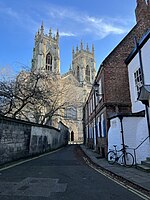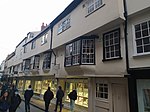Statue of Elizabeth II, York Minster

A statue of Queen Elizabeth II was unveiled at York Minster on 9 November 2022 by King Charles III, two months after the Queen's death in September 2022. The 6ft 7in (2m) tall sculpture was intended to mark the late monarch's Platinum Jubilee and was completed in August 2022, a month before her death. The statue, which stands in a niche on the minster's west front and weighs almost two tonnes, is carved from French lepine limestone. It portrays the Queen wearing her Garter robes and the George IV State Diadem, and holding the orb and sceptre, symbols of authority. The design was chosen by the Queen. The statue was originally to have been unveiled in September 2022, but this was postponed owing to the Queen's death and state funeral that month.
Excerpt from the Wikipedia article Statue of Elizabeth II, York Minster (License: CC BY-SA 3.0, Authors, Images).Statue of Elizabeth II, York Minster
Minster Yard, York Bishophill
Geographical coordinates (GPS) Address Website Nearby Places Show on map
Geographical coordinates (GPS)
| Latitude | Longitude |
|---|---|
| N 53.9621 ° | E -1.0832 ° |
Address
York Minster (St Peters Cathedral)
Minster Yard
YO1 7HH York, Bishophill
England, United Kingdom
Open on Google Maps











